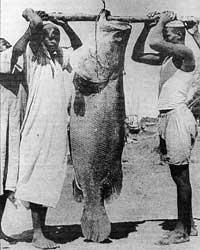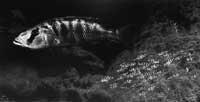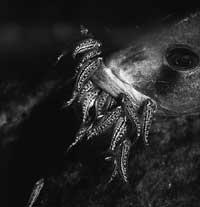Victoria, source of Nile
It was the time of the frenetic search for the sources of the Nile River. English explorer John Hanning Speke was looking for a discovery that would allow him to give him eternal glory in broad corners of East Africa. They worked in the same work, Richard Burton, now more prestigious, and others.

The Sgt.The Sgt.On the evening of July 30, Spek, from the top of a hill, saw a great mass of water. The Arab merchants, specifically the slave traders, called him Ukereue. But it was 1858, the empire of Queen Victoria in the world and Spek, in honor of her queen, gave her the name of Victoria Nyanza. Back in England he proclaimed that he found the source of Nile. Spek was right. However, Burton, his rival, did not believe him because Spek could not resolve where the lake was poured.
In 1862, accompanied by his journey through the Scottish explorer Speke, James Grant, he returned to Africa with the only idea of demonstrating that he was correct. The destination accompanied them. The two explorers found the Ripon waterfalls on the north shore, near the current city of Jinja in Uganda. Of these, the waters of Lake Victoria are poured into Lake Kyoga, the Alberto River, with the name of Nilo Alberto, begins a long journey in the Mediterranean. “I’ve seen the Old Nile born in Victoria Nyanza, no doubt,” Spek wrote.
Today, however, Spek would hardly know the place, since the waterfalls of Ripon, like him, are already history. The Owen Falls Dam ended the Speke test forever in 1954.
Although he was surely not conscious, Spek had something more than the source of Nile. Lake Victoria is one of the most fascinating samples of evolutionary capacity. The Galapagos islands are mentioned as agents of Darwinism, probably because Darwin did not know Lake Victoria (see annex). Unfortunately, like the Ripon Falls, the uniqueness of Lake Victoria can become something of the past.
Biology also contributes the uniqueness of rural geology. Victoria is part of the East African lake system, with Malawi, Tanganika, Turkana and others. These lakes are located in the branches of the fault system which has been the cradle of man. This system extends from the Red Sea to Malawa and in its heart is between the two main branches.

The Victoria is an open water rectangle over the equator. It covers 69,484 square kilometers and is shallow, 80 meters right at the deepest point. The distance between the furthest points is 337 km from north to south and 240 km from east to west. As indicated, it is found in the central depression of the great plain between the east and west branches of the fault system at an altitude of 1.134 m. It has numerous archipelagos and islands, being the largest island of all.
In addition to the lake itself, the shore of the lake is spectacular, varied and surprising. To the South are impressive ravines of 90 m, while the North coast is flat and naked. The eastern edge looks like a mountain, full of teeth, while the western one does not present peculiarities, except the delta of the river Kagera covered of papyrus.
The geological history of Lake Victoria is written in coastal sediments. As can be read in it, in addition to being our major protagonist, he has suffered many incidents. Its duration has also been kili-kolo, when about 13,500 years ago it dried up completely. However, the current changes in the water level are very small, always under a rainy regime of about 30 cm. XX. In the eighteenth century the water level has descended up to 3 m after the great drought of the early 1960s.
The large mass of water, like Lake Victoria, affects the surrounding territories. It is observed to the North and to the West, where in a territory of 45 to 75 km wide the temperature varies between 16 ° and 27 ° C and it rains uniformly throughout the year. As a result, these regions are covered by the tropical rainforest.
The lake is in serious danger. Greatness does not exempt Victory from the dangers of modern society. Unfortunately, the size does not, by itself, ensure solidity and durability. XX. In a context of wastage of remains of the twentieth century, the lake must face three challenges: pollution, the proliferation of algae and the reduction of fish stocks. For anyone who knows something about the deterioration of ecosystems, it is not the three new or unknown problems, but those that occurred on Earth everywhere.

Even knowing that these risks are going to be a deterioration of nature, it would be timid to analyze the condition of the lake only from the ecological point of view or the conservationism of nature. These risks will endanger the economy and society as a whole. Today the lives of 30 million people depend on the resources offered by the lake and the economy of the coastal states is based on the waters of Victoria. For example, fishing on the lake is currently the main exporting product of Uganda.
Water pollution is something new in Lake Victoria and is linked to the industrial development of edge states. Therefore, at the margins of the lakes of Kenya and Tantzania, with the highest degree of industrialization, are the main problems and sources of pollution. At the level of pollution, in addition to industry, agriculture and urban spills have an important weight. Thus, the fertilizers and insecticides used in coffee, tea, sugar cane and maizales plantations are the main causes of agricultural pollution. Unfortunately, the use of these products has grown very quickly in the last ten years.
The surroundings of the Kenyan cities of Kisumu and Mwanza, in Tanzania, are the ones that have the greatest brand of pollution. A recent study reveals that in the stretch of Lake Tantzania two million liters of non-purified industrial and urban waste are poured daily.
To all this we must add the phytosanitary problems caused by urban wastewater. Many of the inhabitants of the shore of the lake and the crewmembers and passengers of the boats sailing through the lake drink directly the water of the lake without any problematic treatment. Consequently, diseases that develop in water, such as typhus, cholera, diphtheria and diarrhea, are those that can be multiplied.
Lake Victoria, the main source of Nile, does not have its pollution problems by limiting the shores of the lakes and arriving through the mythical river to the Mediterranean, where other lakes and countries will get dirty.
In this sense, international cooperation and coordination are fundamental. However, the will of the coastal states is not very clear. Kenya has harsh anti-pollution laws, but they rarely apply. When applied, moreover, the sanctions are usually mild. They are useless. The other two problems of the lake have their origin in nature, although the liver has the hand of man to become a danger. The water hyazinth and the perch of the Nile are responsible for the ecological balance of the lake.
Water hyazinth is more recent than pollution. It appeared on the lake around 1989 from Rwanda through the Kagera River. This floating seaweed, of South American origin, is forming a green, consistent and compact layer on water without natural enemies, condemning fish and other living beings to die without oxygen. It reproduces quickly and very well the organic matter coming from agricultural and urban waste to feed itself. It has become a plague. About 70% of Uganda's docks have already been blocked by algae.
The aquatic hyacinth, for its part, has created an environment conducive to the proliferation of mosquitoes transmitting malaria and rodents generating bilharzisis. Agriculture is also not free of risk, since algae block the channels of irrigation systems.
The fight against algae is not easy either. It is largely uncontrollable. Two paths try. On the one hand, the mechanical collection of algae and its subsequent use as biogas or animal feed and, on the other, the use of some natural enemy of algae. Currently, Lake Kyoga is rehearsing with an argento beetle brought from Benin. This also poses a risk, because it puts on the table the question always: Who controls the controller?
The perch of the Nile is older on Lake Victoria. In 1957 the first remains of this fish were discovered. The perch of the Nile, as its name indicates, lives in the lakes of the river basin, as those of Alberto and Turkana. In any case, the population of Lake Victoria is not resident. The issue has provoked many controversies. However, no one argues that it has changed the balance of the fish species of the lake perca of Nile. At this time, therefore, to see who provoked the debate is sterile because it does not solve the problem.

Before arriving in Perka, the lake was dominated by cichlid fish. The majority small, haplochrominous and others, slightly larger the tilapia. Many species of haplocrominus, about 200, were endemic in the lake, that is, they were nowhere else (see "Treasure of biodiversity"). When Perka arrived it broke the ecological balance reached for thousands of years.
The perch of the Nile is a predator that can reach 200 kg and when arriving to the lake the haplocrominos became their prey. Haplocromins are not used to living with perch and, without defensive mechanisms, they have become an easy way to quench the hunger of perch. Therefore, the perch reproduces disfiguratively. For example, perch accounted for 0.5% of fish slaughtered in Kenyan waters in 1977, compared to 68% in 1983. According to estimates by scientists, 80% of the weight of the lake is currently perch.
All this has caused the disappearance of some species of haplocromins and the appearance of other red. Biodiversity is being lost and, at the same time, the way of life of its people.
The people of Lake Victoria have been, to a large extent, haplocrominos. Fish, eat and dry the surplus and sell them inside. In this place, where animal protein is scarce, small cichlids are cheap and easy to prepare (they were) and are available to the public (they were). To achieve this, the nets of capture of fish and the drying of the dams are only necessary the sun. The commercialization of fish is easy (era), since no packaging system or sophisticated transport network was needed. Dry fish lasts several weeks in good condition. The perch of the Nile, on the other hand, is oily and large and, unfortunately, can not be processed according to conventional methods, since to preserve it you have to remove it. The wood is, therefore, a scarce resource in many points of the shore.
Perch fishermen have also had to change the fishing techniques. More robust networks are now used, with more mesh and more faces. This has brought good news to some smaller fish species of the lake. Tilapia subjected to strong fishing pressure are slowly recovering.
Scientists are clear that the growth of the Nile's perch population has limits and perhaps has already reached. The population of haplochromins has decreased dramatically. Therefore, the percas have to go to another place in search of food. In addition, a sweet drink of water of the genus Caridina has become a new prey. This will mean a decrease in the perch population. The fishing is complicated and the economy of the lake suffers a hard blow. When? It is not clear, but it will be impassible. Hunger can unexpectedly turn into Lake Victoria.
Short space of time, but effective. It has only been a century and a quarter since the western white man discovered Lake Victoria. They are less than forty years since man began to apply techniques of exploitation of developed civilizations in him. It is not long, the grain on the beach of time. However, for thousands of years it has been enough to disintegrate, damage and endanger nature. As an example of Darwin's evolution, like the Galapago islands, this African example of evolution can be an ancestral issue for our children.

Treasure of biodiversity

A rock bottom of Lake Victoria can be the nest of many species of haplocrrominos. These small fish are of varied colors, granulated. A species can have long teeth and an intestinal cheek, ideal to take small crustaceans that travel through the stone slits. Another, with wide mouth and small teeth, is dedicated to spinning algae glued to the stone. Other haplochromins have developed teeth and mouths to exploit a certain biotope of the lake, both in surface and deep waters.
Inside the lake, hundreds of species of haplochromins have evolved, each with a different ecological corner. The fascination and expressive proof of Darwinism. How has it been possible?

These species have evolved in a short period of time and have developed their own characteristics. They can be compared with the txontes of the islands of Galapagos, but multiplying the phenomenon by infinity of times. It seems that haplocrromins have evolved since the lake dried 13,000 years ago. According to the biologists, when the lake was dried, the haplochromins were trapped in the wells and each developed its own characteristics. When the water returned to cover the land, the fish were no longer able to raise each other and continued as separate species.
An example of the rapid evolution capacity of these fish is Lake Nabugabo. This lake was born 3,500 years ago when a sand bar separated part of the waters of Lake Victoria. Subsequently, five other species have evolved.
Haplochromins have a great territorial sense, so all individuals of some species of haplocrromins live in a space of a few thousand square meters.
The form of reproduction is curious. Offspring that grow in the mouth of their mother. The majority of fish species lay thousands of eggs and from fertilized eggs are formed thousands of offspring. However, eggs and offspring are an easy prey for predators, and thousands of eggs are made up of enough adult specimens.

The haplochromins lay few eggs. It all starts when the male anida. In this regard, the carved courtship is proceeded to attract the attention of the female. The female lays the eggs one by one and then puts them in the mouth. Then rub the genital area of the male so that the male pour sperm into the water. The female ingests sperm fertilizing the eggs. The female carries the eggs in her mouth until the young are formed, and the mouth is still a refuge for young people until they are able to live on their own.





